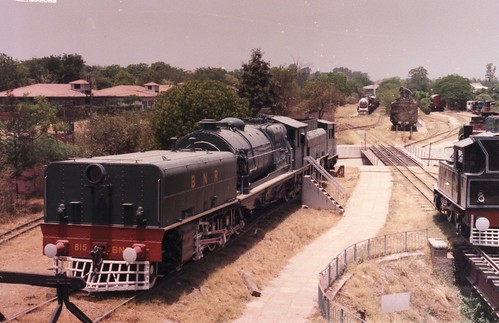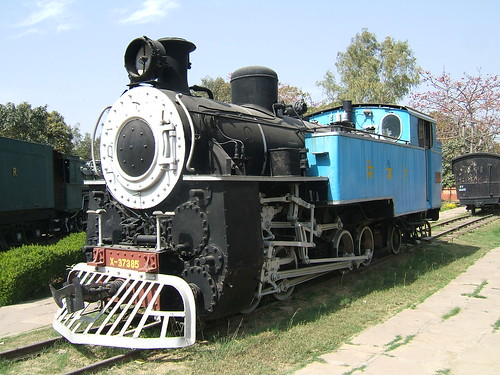Myanma Railways are committed to a number of projects to build new railways to improve communications in Myanmar. One of these projects is providing a railway line from Katha (on the west bank of the Ayeyarwaddy River) to Bhamo (further north, on the east bank of the Ayeyarwaddy River).
Katha is already served by an existing branch line from the junction at Naba with the line from Mandalay to Myitkyina in Kachin State.
The line from Katha to Bhamo was started in May, 2007. The work is divided into three sections: Katha-Kyautkyi (length 37.06 miles), Kyautkyi-Simkhan (28.26 miles) and Simkhan-Bhamo (29.56 miles), giving a total length of 94.88 miles.
Section 1. Katha - Kyautkyi: The line from Katha to Moe Tar Kyi line opened on 20th October 2010 and from Moe Tar Kyi to Kyautkyi line on 7th February 2014. There are 141 bridges in this section. 132 bridges have a span of less than 40 feet, 8 bridges have a span between 40 and 180 feet and one bridge has a span exceeding 180 feet.
The line is controlled by the following Block Stations: Katha, Paw Ma Myaing, Min Le, Moe Tar Kyi, Choung Wa and Kyautkyi. These stations are provided with fixed distant signals and working Outer Signals. Block Working uses paper 'Line Clear' forms.
A regular passenger service is now operated on this section by diesel railcars type RBE (brief details in the post Diesel Railcars in Burma). The Line Speed Limit is currently 15 miles/hour. The line from Katha to Choung Wa is in Sagaing Division: beyond Choung Wa, the line is in Kachin State.
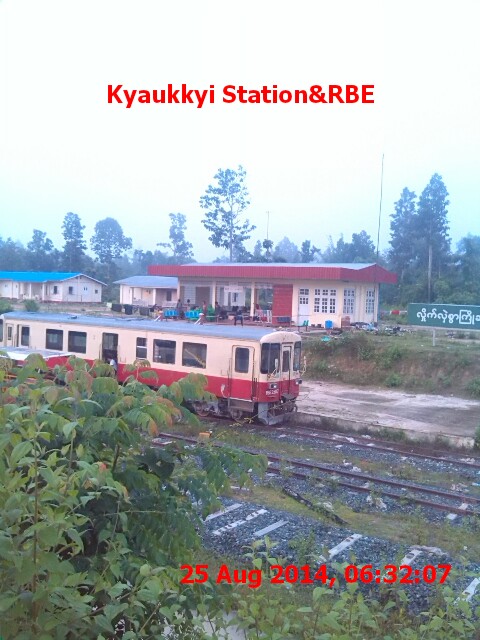
Kyaukkyi Station, Myanmar (Photo: Htein Lin)
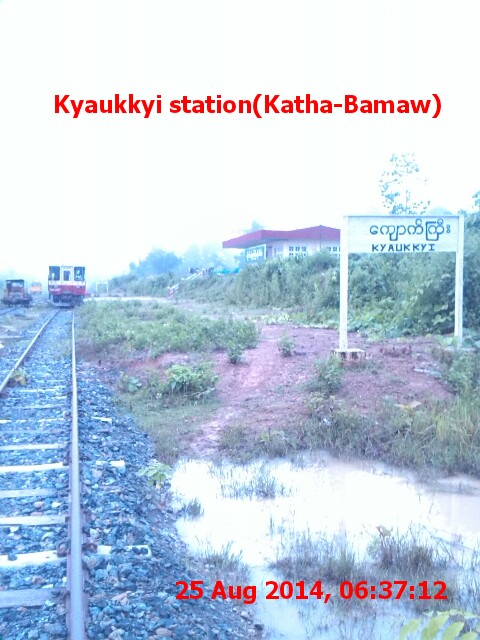
Kyaukkyi Station, Myanmar (Photo: Htein Lin)
Section 2. Kyautkyi - Simkhan: This section has 129 bridges, all completed. This section will have Block Stations at Myo Kone and Simkhan. Stations and signals will be similar to section 1.
Section 3. At Simkhan, a major road/rail bridge across the Ayeyarwaddy River has been built. The remainder of section 3 to Bhamo is under construction.
The new junctions at Katha
I've made two round trips from Katha to Naba, both times on special trains operated in connection with 'Road to Mandalay' river cruises. The first railway trip was in 2010 (when I travelled in the locomotive cab) and those journeys are described in the (technical) posts Cab Ride from Katha and Cab Ride back to Katha. Two years later, I repeated the trip, described in the post By Train to Naba. Each of these posts has links to the associated photographs.
On the first railway trip in 2010, I was intrigued to discover an unexpected triangular railway junction about 3.5 km from the terminus at Katha.
The photograph below was taken from the locomotive cab on the return journey from Naba to Katha in 2010 shows the new line to Bhamo trailing off to the left. There is a handsignalman, the usual single lever to operate the junction points which are then secured with a point clip. 'Stop' signals are provided but were not operated - the handsignalman giving a Green Flag as authority to proceed. The bamboo shelter at the junction appears to be for the handsignalman's use.
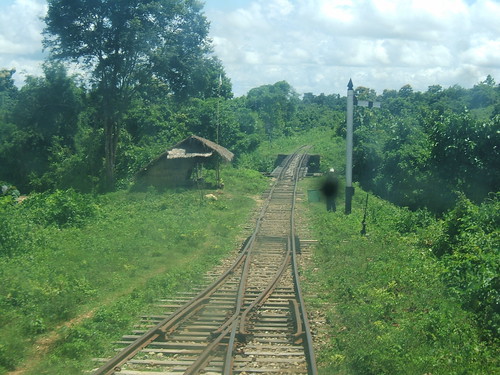 The new junction viewed from a train on the Naba to Katha line, looking towards Katha showing the new line to Bhamo trailing off to the left.
The new junction viewed from a train on the Naba to Katha line, looking towards Katha showing the new line to Bhamo trailing off to the left.
The photograph below, taken from the train on the Naba to Katha line in 2012, shows the new line to Bhamo curving away to the right. Note the single point lever controlling 'trap' points which, when open as in the picture, will derail any vehicles approaching the junction from the new line, providing 'flank' protection to a train on the Naba to Katha Line. A 'Stop' signal is also provided.
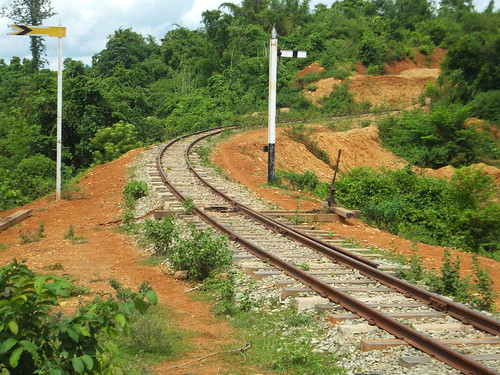 The new line to Bhamo curving away to the right, viewed from a train on the Naba to Katha line.
The new line to Bhamo curving away to the right, viewed from a train on the Naba to Katha line.
The photograph below, taken from the train on the Naba to Katha line in 2012, shows the 'third side' of the triangle, which would allow a train from Naba to divert towards Bhamo, rather than proceeding to Katha. Note mix of timber and concrete sleepers. The undergrowth between the rails testifies to the line not being in regular use.
 The 'third side' of the triangle, viewed from a train on the Naba to Katha line.
The 'third side' of the triangle, viewed from a train on the Naba to Katha line.
The new bridge at Simkhan
In 2012, I visited Bhamo on the 'Road to Mandalay' cruise ship and I took the photographs below of the Simkhan bridge, commenting:-
"We passed under the New Bridge which appears almost complete. There are eight steel truss spans but only the one we used was marked for river traffic. There were 'traffic lights' on the bridge piers but they were not lit. The bridge carried a lane for road traffic (equipped with lighting standards), a single track metre gauge railway and a pedestrian lane. On either side of the bridge spans, there are reinforced concrete approach viaducts. I was told that the railway track on the west bank will be connected to the triangular junction at Katha and will be extended to Bhamo on the east bank."
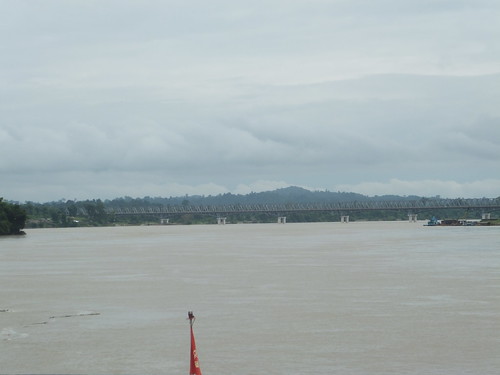 The Simkhan Road/Rail Bridge, Ayeyarwaddy River.
The Simkhan Road/Rail Bridge, Ayeyarwaddy River.
 West bank of the Ayeyarwaddy River, showing the Simkhan Road/Rail Bridge.
West bank of the Ayeyarwaddy River, showing the Simkhan Road/Rail Bridge.
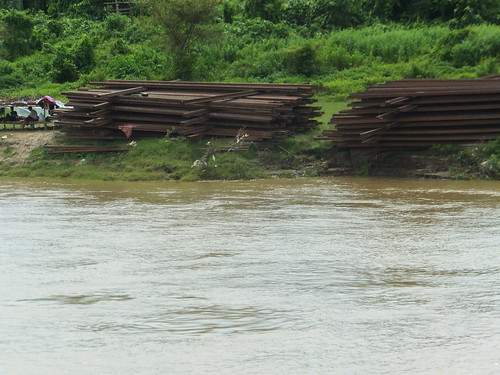 Rails stockpiled, awaiting use: Simkhan Road/Rail Bridge, Ayeyarwaddy River.
Rails stockpiled, awaiting use: Simkhan Road/Rail Bridge, Ayeyarwaddy River.
Acknowledgments
I am grateful to Myanma Railways staff for providing much of the information in this post but any errors are my own.
Related posts on this website
I've made two visits to Bhamo by river (on the 'Road to Mandalay' cruise ship) in 2010 and again in 2012. There are a number of (non-technical) posts on these trips - those for 2010 are here and those for 2012 are here. These posts have links to photograph albums where there are more pictures of the railways and river bridge.
